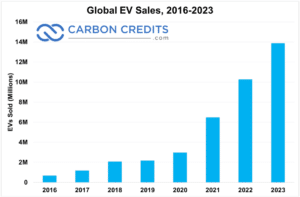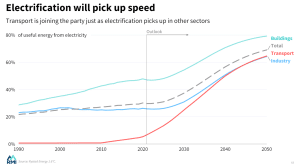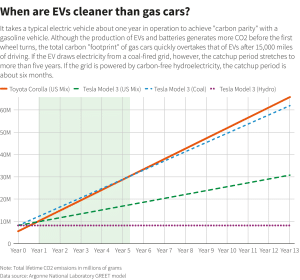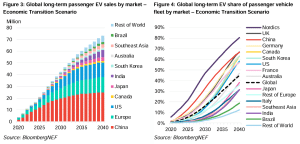Amid the rapid adoption of electrification, electric cars are reshaping the automotive industry, promising enhanced performance, efficiency, and a cleaner future. This momentum is seized by yet other big players in the vehicle industry, Audi and Alfa Romeo. Both have revealed their innovative electric car models: the 2025 Audi E-Tron GT and the Alfa Romeo Milano.
Driving the Electrification Revolution
The electrification movement, driven by advancements in battery technology and supportive policies, underscores a pivotal shift toward sustainable transportation solutions.
According to the International Energy Agency (IEA), global electric car sales surged to nearly 14 million vehicles, with 95% of these sales occurring in China, Europe, and the United States in 2023. This marked a significant increase from previous years, totaling 3.5 million more electric cars sold compared to 2022, representing a remarkable 35% year-on-year growth.


The total number of electric cars on the roads globally reached 40 million by the end of 2023, closely aligning with forecasts from the Global EV Outlook 2023.
The rapid adoption of electric vehicles (EVs) is underscored by the fact that in 2023, there were over 250,000 new electric car registrations per week, surpassing the entire annual total from a decade earlier in 2013.
Furthermore, electric cars accounted for about 18% of all cars sold globally in 2023, up from 14% in 2022 and a mere 2% in 2018. This highlights the robust growth and maturation of the electric vehicle market.
This trend underscores the increasing preference for EVs, driven by battery technology advancements, expanding charging infrastructure, and supportive policies. All these aimed at reducing emissions and promoting sustainable transportation solutions.
In another report by RMI, transportation will keep pace with other sectors in electrification by 2050.


Riding along this electrification trend are Audi and Alfa Romeo, which both revealed their latest EV models.
Meet The Most Powerful Audi Ever
The 2025 Audi E-Tron GT has received a significant update following its Porsche Taycan counterpart earlier this year. Available in three variants, this electric sedan boasts enhanced power, charging speeds, and range.
The flagship RS E-Tron GT Performance emerges as Audi’s most powerful production vehicle ever, delivering 912 horsepower and accelerating from 0 to 62 mph in just 2.5 seconds, slightly slower than the Taycan Turbo GT.
All models feature dual-motor all-wheel drive and benefit from an upgraded battery pack, now with 97.0 kWh capacity (up from 84.0 kWh), supporting a 320 kW maximum charging power. Charging from 10% to 80% takes 18 minutes under optimal conditions, providing 174 miles of range in just 10 minutes.
Introducing Alfa Romeo’s First Electric Car
The Alfa Romeo Milano, a new small SUV under the Stellantis group, marks Alfa Romeo’s debut in electric vehicles (BEV) alongside a hybrid version. It aims to enhance sales within the expansive Stellantis portfolio, which includes Fiat, Jeep, Peugeot, and Vauxhall.
The Milano showcases Italian design flair with a compact silhouette and distinctive features such as the ‘scudetto’ grille and advanced LED headlights. It stands 4.1m long, 1.5m tall, with short overhangs and a truncated rear reminiscent of the Sixties Giulia TZ.
Built on the eCMP platform, it offers up to 238bhp from its electric motor and boasts a range of about 250 miles.
Alfa Romeo’s transition to electric power is crucial in reducing carbon emissions from vehicles, aligning with global efforts to mitigate environmental impact and promote sustainable transportation solutions.
How Clean is An EV vs. A Fossil Fuel Car?
A research done by the European Energy Agency suggested that EVs emit up to 30% less carbon than gas- or diesel-powered cars. Moreover, electricity sourced from clean energy or low-carbon sources further lowers the environmental impact of EVs.
Additionally, a Reuters analysis revealed that in worst case scenario (EV is charged from a coal-fired power source), an EV would release 4.1 million grams of CO2 a year. In contrast, a comparable gas car can generate over 4.6 million grams.


Accelerating EV Adoption in the United States
The United States saw robust growth in new electric car registrations last year, totaling 1.4 million vehicles—an increase of over 40% compared to 2022, per IEA data.
Although the year-over-year growth rate was slightly lower than in the preceding years, the demand for EVs remained strong. This is supported by revised qualifications for the Clean Vehicle Tax Credit and price reductions across popular EV models.
The updated criteria under the Inflation Reduction Act (IRA) played a pivotal role in boosting sales. Notably, the Tesla Model Y’s sales surged by 50% in 2023 after it became eligible for the full $7,500 tax credit.
Despite initial concerns about potential bottlenecks due to stricter domestic content requirements for EV and battery manufacturing, vehicles like the Ford F-150 Lightning were able to navigate these challenges.
Looking ahead, the number of new EV models reaching the market is poised to accelerate. BloombergNEF projects that EVs could reach 45% of global passenger-vehicle sales by 2030 and 73% by 2040.


These trends speak of the continued expansion of electric vehicle adoption in the US and beyond, underscoring the resilience of the EV market despite evolving regulatory landscapes and changing incentives. As the window for reaching net zero emissions in transportation is closing quickly, EVs remain the most cost-effective route to decarbonize the sector.
- SEO Powered Content & PR Distribution. Get Amplified Today.
- PlatoData.Network Vertical Generative Ai. Empower Yourself. Access Here.
- PlatoAiStream. Web3 Intelligence. Knowledge Amplified. Access Here.
- PlatoESG. Carbon, CleanTech, Energy, Environment, Solar, Waste Management. Access Here.
- PlatoHealth. Biotech and Clinical Trials Intelligence. Access Here.
- Source: https://carboncredits.com/audi-and-alfa-romeo-take-the-ride-to-electrification/



